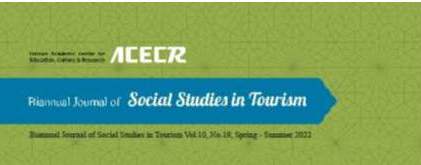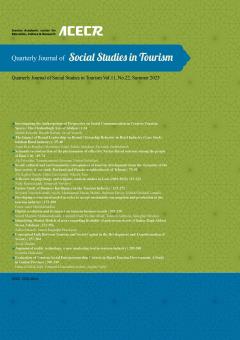-
-
List of Articles
-
Open Access Article
1 - Anthropology of Tourism, Creative Space, Creative Tourism, Social Communication
mehdi karoubi razieh Rabani Javad Yousefi -
Open Access Article
2 - Brand Citizenship Behavior, Brand Leadership, Brand Passion, Isfahan, SEM
amirreza konjkav monfared saeid saeida ardakani farzaneh zarabkhaneh -
Open Access Article
3 - Semantic reconstruction of the phenomenon of collective Nature-Based tourism among the people of Ilam City
Ali Feizolahi yarmohammad ghassemi farhad sabzifard -
Open Access Article
4 - Investigating the Social, Cultural, and Environmental Consequences of Tourism Development from the Host Community Perspective: A Case Study of Darband and Darakeh Neighborhoods of Tehran, Iran
Aliasghar Saeidi Zahra Farzizade Soheila Tasa -
Open Access Article
5 - A Formal and Contentual Review of Pilgrimage and Religious Tourism Studies in Iran (2003-2021)
Neda Razavizadeh somaye varshoe -
Open Access Article
6 - A Future Study of Business Intelligence in the Tourism Industry
nayereh abtahi Mohammad Hasan Maleki behrooz bayat tohfeh ghobadi -
Open Access Article
7 - Developing A Structural Model for Establishing A Sustainable Consumption and Production Pattern in Tourism Industry
Faezeh Mirfakhraee -
Open Access Article
8 - Investigating the Effect of Digital Revolution on Tourism Business Trends
Seyed Mojtaba Mahmodzadeh Fatemeh Izadi Yazdanabadi Tahereh Ashtiani Aliasghar Heydari -
Open Access Article
9 - Investigating the Citizens' Attitude Towards Liveliness of Pedestrian Streets: A Case Study of Charbagh Abbasi Street, Isfahan, Iran
Zahra masaeli samar haghighi -
Open Access Article
10 - Investigating A Conceptual Link Between Tourism and Social Capital in the Development and Transformation of Society: A Mixed-Method Study
Javad Madani -
Open Access Article
11 - Augmented Reality Technology: A Novel Marketing Tool in Tourism Industry
niloufar hadianfar -
Open Access Article
12 - Assessing Social Entrepreneurship Criteria in Rural Tourism Development: A Case Study of Gilan Province, Iran
Hamed Fallah Tafti Fatemeh Doozandehziabary Asghar Nabil
-
The rights to this website are owned by the Raimag Press Management System.
Copyright © 2017-2025







